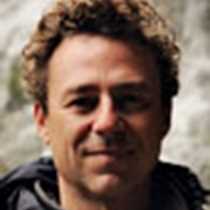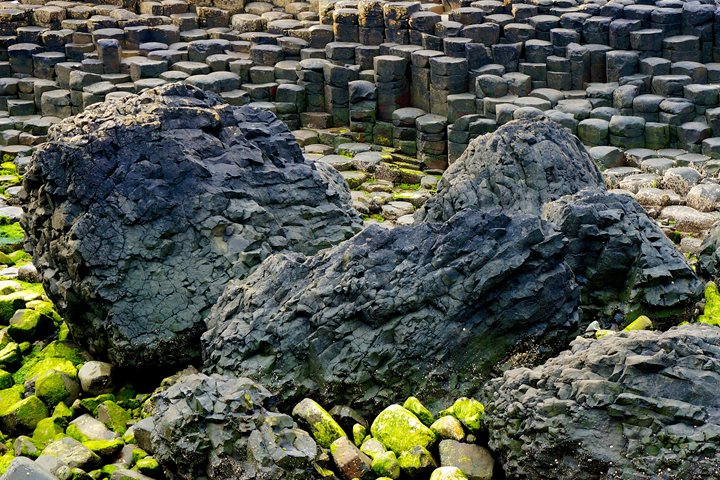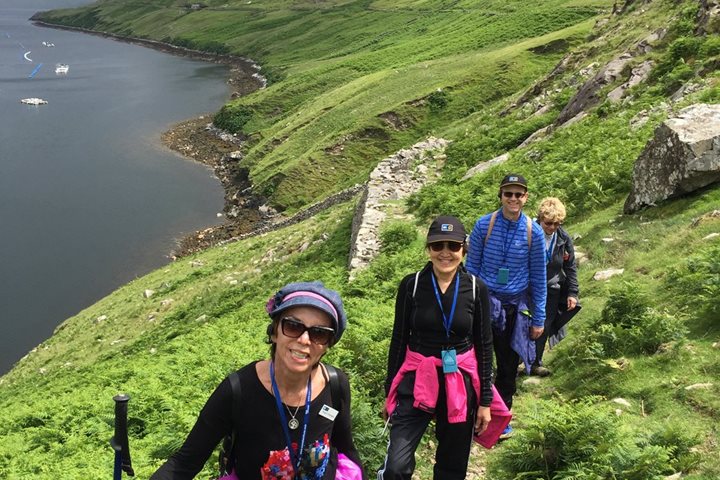Our day in Killybegs and its surroundings offered a look into Ireland's past and a vision of its future. This is a country where history reveals itself around every turn, and sometimes the juxtapositions between the old and the new can be quite jarring. Today, we saw ancient monuments from prehistoric times incongruously sitting by the side of the road like druidic traffic signs. We visited a model village where we witnessed techniques for knitting traditional fishing nets and weaving ropes from straw on the same day we passed by factories of fast-growing, hi-tech electronics companies specializing in outfitting ships across the world with the latest technologies. The dock where National Geographic Orion berthed in Killybegs, a quiet, somewhat non-descript village that happens to be Ireland's largest fishing port, was lined with the enormous disassembled sections of brand-new wind turbines, destined to provide clean energy for this fast-developing country.
Even our young guide at Glencolmcille Folk Center, which was established over 50 years ago to preserve the architecture, artifacts, and folk traditions of this region's rural communities represented Ireland's blend of old and new. Above his waist Kevin was dressed in a classic Irish tweed vest over a traditional pullover shirt that would have fit right into a pre-twentieth century daguerreotype print. He complemented this traditional look with sweat pants and Adidas. Kevin might not have intended to symbolize the ways in which modernity and tradition exist side by side in Ireland, but I couldn't resist making the metaphorical comparison.
Our journey through the hill country southwest of Donegal took us past magnificent views, moss-covered ruins, and up and down nerve-wracking single-track roads, where every oncoming vehicle required a series of polite maneuvers in order to allow both parties to proceed on their way.
At one point, we found ourselves in a small village where we stopped to pay a visit to a local woolen craft studio where veteran weavers churn out beautiful tweed on traditional looms. We spoke to one man behind a loom, John, who had been working here for 46 years. I asked him if it was backbreaking work, sitting on the hard wooden bench of an old loom every day, pushing levers back and forth to create the intricately patterned cloth that is used to make iconic Irish hats, scarves, and jackets. Quite the contrary, John told me. He loved his work, which had afforded him a happy life that he was proud of. While none of his sons continued in the tradition, he pointed at the young man sitting at the loom behind him who led John to have confidence that this important handicraft will continue to be practiced by future generations.
Our day ended at the Bayview Pub in the center of Killybegs, where we were treated to a live performance by Socks in the Frying Pan, one of the hottest up-and-coming bands in the Irish traditional music scene. Brothers Shane and Fiachra Hayes, the former playing button accordion and the latter violin, with guitarist Aodan Coyne rounding out the trio, presented a virtuosic set that ranged from upbeat jigs and reels to haunting acapella ballads. All three hail from Ennis in County Clare, considered one of the epicenters of Irish traditional music today. They were raised by musical families who gave them the techniques, repertoire, and passion for Irish music that led these three 20-something musicians to pursue careers in the traditional music arena. Watching these three young musicians bringing new influences and youthful creativity to folk songs that have been passed down for generations was a fitting end to a day in which the past and the future existed side by side in perfect harmony.






